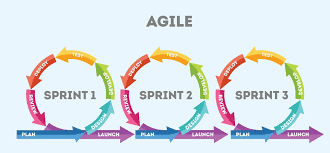Unlocking Success: The Power of Agile Development in Software Engineering
The Evolution of Agile Development in Software Engineering
Agile development has revolutionized the software engineering industry by emphasizing flexibility, collaboration, and rapid iterations. Unlike traditional waterfall methodologies, agile approaches prioritize adaptability and customer feedback throughout the development process.
Key Principles of Agile Development:
- Iterative Approach: Agile development breaks down projects into smaller iterations or sprints, allowing for continuous improvement and adjustment based on feedback.
- Collaborative Environment: Cross-functional teams work together closely to deliver high-quality software efficiently.
- Customer Involvement: Customers are involved throughout the development process, providing feedback that helps shape the final product.
- Adaptability: Agile teams are adaptable and responsive to change, adjusting priorities and requirements as needed.
- Rapid Delivery: By focusing on delivering working software in short cycles, agile development accelerates time-to-market and enables quick responses to market demands.
The Benefits of Agile Development:
Implementing agile methodologies in software engineering offers numerous advantages, including:
- Improved Product Quality: Continuous testing and feedback lead to higher-quality software that better meets customer needs.
- Enhanced Customer Satisfaction: Regular interactions with customers ensure that their requirements are understood and incorporated into the product.
- Faster Time-to-Market: Agile development allows for quicker delivery of features and functionalities, giving companies a competitive edge.
- Better Risk Management: The iterative nature of agile development helps identify and address risks early in the process.
- Innovation and Creativity: Agile teams have the flexibility to experiment with new ideas and solutions, fostering innovation within the organization.
The Future of Agile Development:
As technology continues to evolve rapidly, agile development will remain a cornerstone of successful software engineering practices. Organizations that embrace agility can adapt quickly to changing market conditions, deliver value to customers faster, and stay ahead of the competition in today’s dynamic business landscape.
7 Essential Tips for Effective Agile Development in Software Engineering
- Encourage collaboration and communication among team members.
- Prioritize customer satisfaction by delivering working software frequently.
- Embrace changes in requirements, even late in development.
- Focus on delivering a minimum viable product (MVP) to gather feedback early.
- Empower the team to self-organize and make decisions collectively.
- Regularly reflect on how to become more effective as a team and adjust accordingly.
- Use tools and processes that promote transparency and visibility of project progress.
Encourage collaboration and communication among team members.
Encouraging collaboration and communication among team members is a fundamental tip in agile development within software engineering. By fostering open dialogue and teamwork, team members can share ideas, feedback, and insights more effectively. This collaborative environment not only enhances the quality of the software being developed but also promotes a sense of ownership and accountability among team members. Clear communication channels ensure that everyone is aligned on project goals, priorities, and progress, leading to smoother workflows and increased productivity in achieving project milestones.
Prioritize customer satisfaction by delivering working software frequently.
In agile development, prioritizing customer satisfaction by delivering working software frequently is a key principle that drives success. By focusing on providing tangible results to customers in short, iterative cycles, teams can gather valuable feedback early on and make necessary adjustments to meet customer needs effectively. This approach not only ensures that the final product aligns with customer expectations but also fosters a collaborative relationship between development teams and clients, leading to improved communication and ultimately higher levels of customer satisfaction.
Embrace changes in requirements, even late in development.
In agile development within software engineering, it is crucial to embrace changes in requirements, even late in the development process. By remaining flexible and open to modifications throughout the project, teams can respond effectively to evolving customer needs and market demands. Embracing changes late in development allows for continuous improvement and ensures that the final product meets the most up-to-date requirements, ultimately leading to greater customer satisfaction and a more successful software solution.
Focus on delivering a minimum viable product (MVP) to gather feedback early.
In agile development within software engineering, a key tip is to prioritize delivering a minimum viable product (MVP) to gather feedback early in the development process. By focusing on creating a basic version of the product with essential features, teams can quickly release it to users for feedback. This approach allows for early validation of concepts, identification of potential improvements, and alignment with customer needs. Gathering feedback on the MVP enables teams to iterate efficiently, refine the product based on real user input, and ultimately deliver a final product that better meets customer expectations.
Empower the team to self-organize and make decisions collectively.
In agile development within software engineering, empowering the team to self-organize and make decisions collectively is a crucial tip for success. By fostering a collaborative environment where team members have the autonomy to organize their work and make decisions together, organizations can unlock the full potential of their workforce. This approach not only promotes creativity and innovation but also enhances team morale and ownership of the project, leading to more efficient problem-solving and higher-quality outcomes. Encouraging self-organization and collective decision-making empowers individuals to take ownership of their work and fosters a culture of collaboration that drives continuous improvement in the development process.
Regularly reflect on how to become more effective as a team and adjust accordingly.
Regularly reflecting on ways to enhance team effectiveness is a fundamental tip in agile development for software engineering. By engaging in continuous self-assessment and adjustment, teams can identify areas for improvement, capitalize on strengths, and adapt their processes to work more efficiently together. This practice fosters a culture of learning and growth within the team, ultimately leading to increased productivity, better collaboration, and the delivery of higher-quality software solutions.
Use tools and processes that promote transparency and visibility of project progress.
To enhance the efficiency and effectiveness of agile development in software engineering, it is crucial to utilize tools and processes that foster transparency and visibility of project progress. By implementing tools such as project management software, version control systems, and collaborative platforms, team members can easily track tasks, share updates, and monitor the status of the project in real-time. This transparency not only promotes better communication and collaboration within the team but also enables stakeholders to have a clear understanding of the project’s trajectory, leading to informed decision-making and successful project outcomes.




